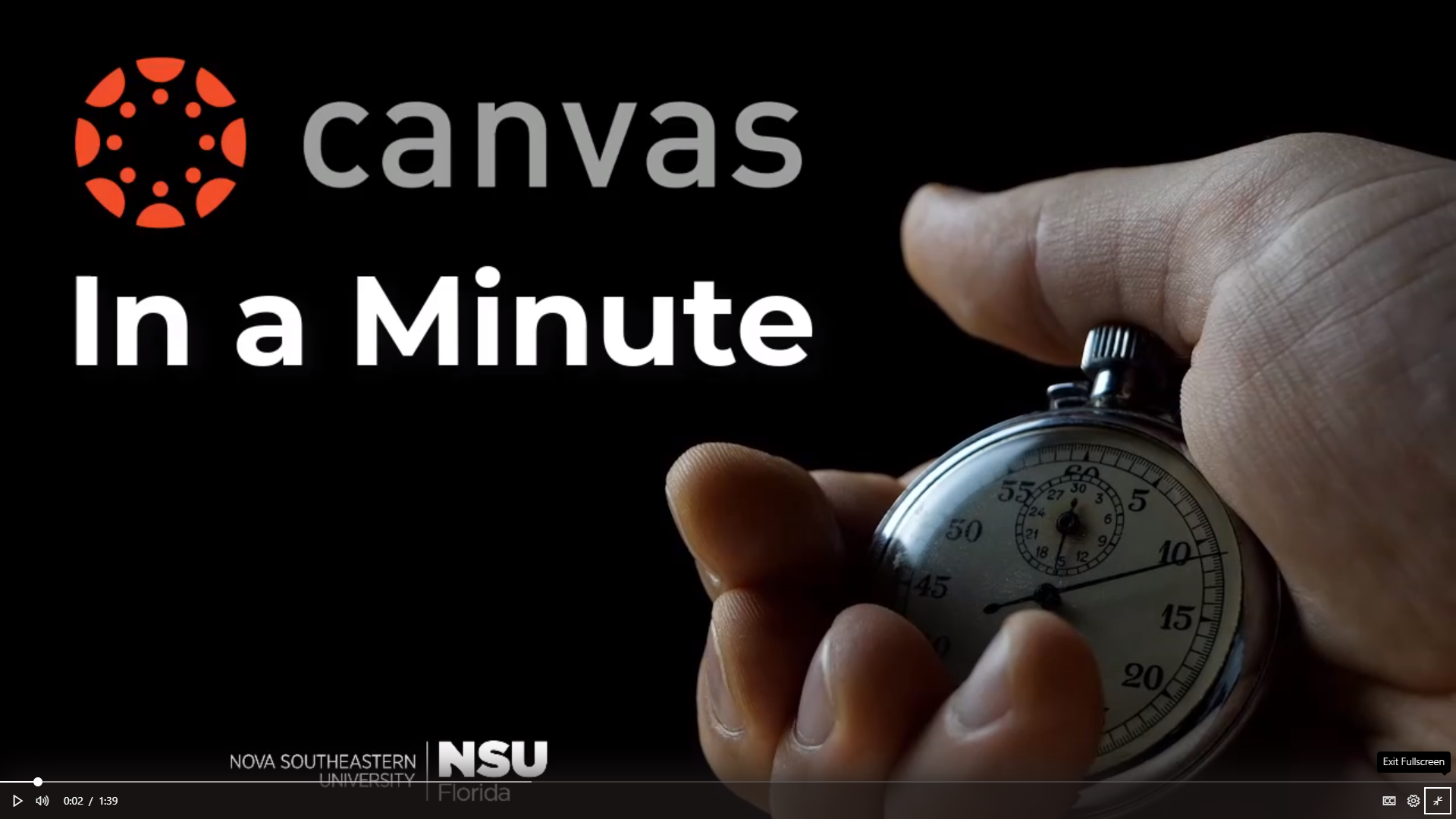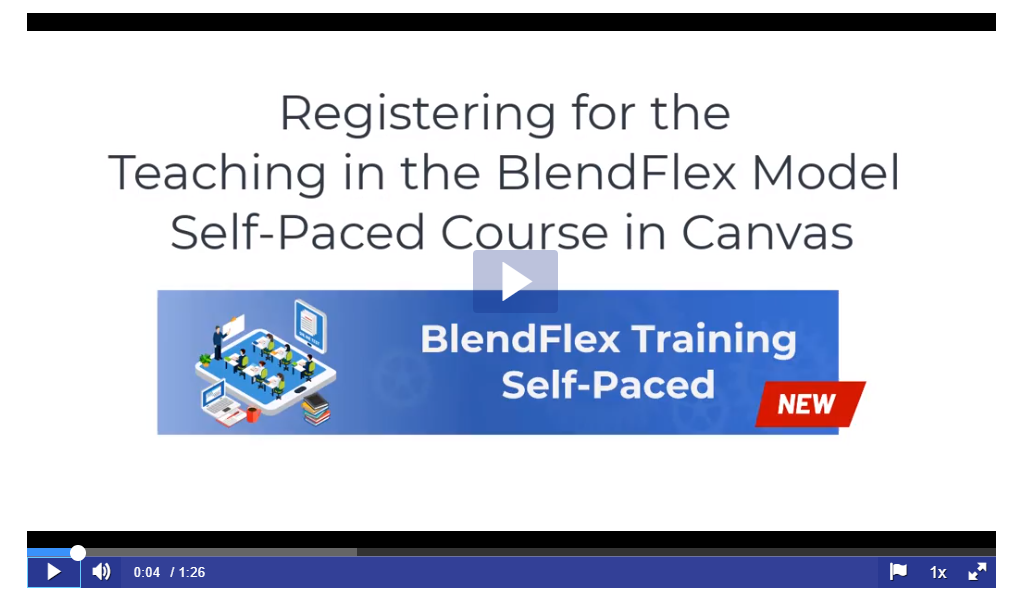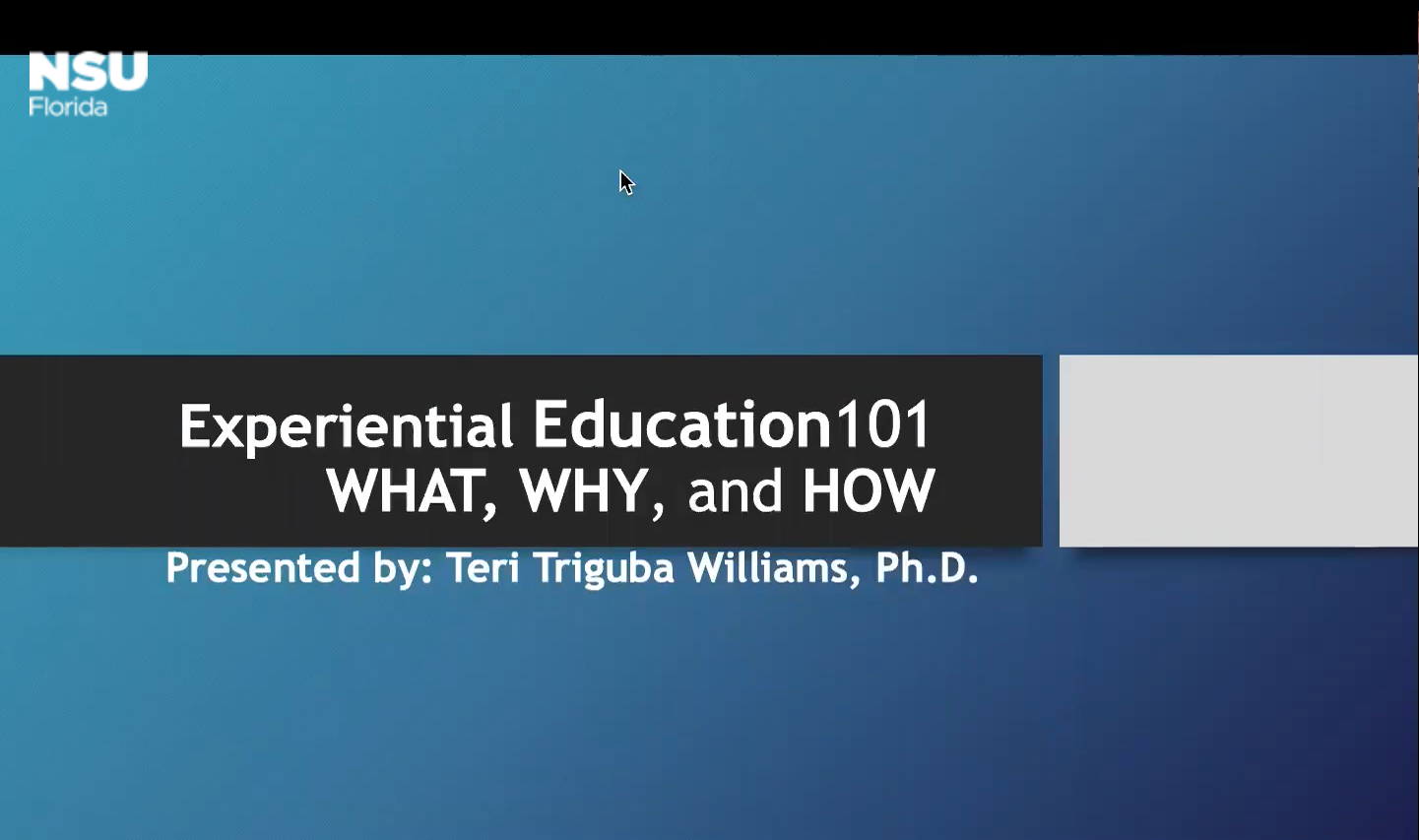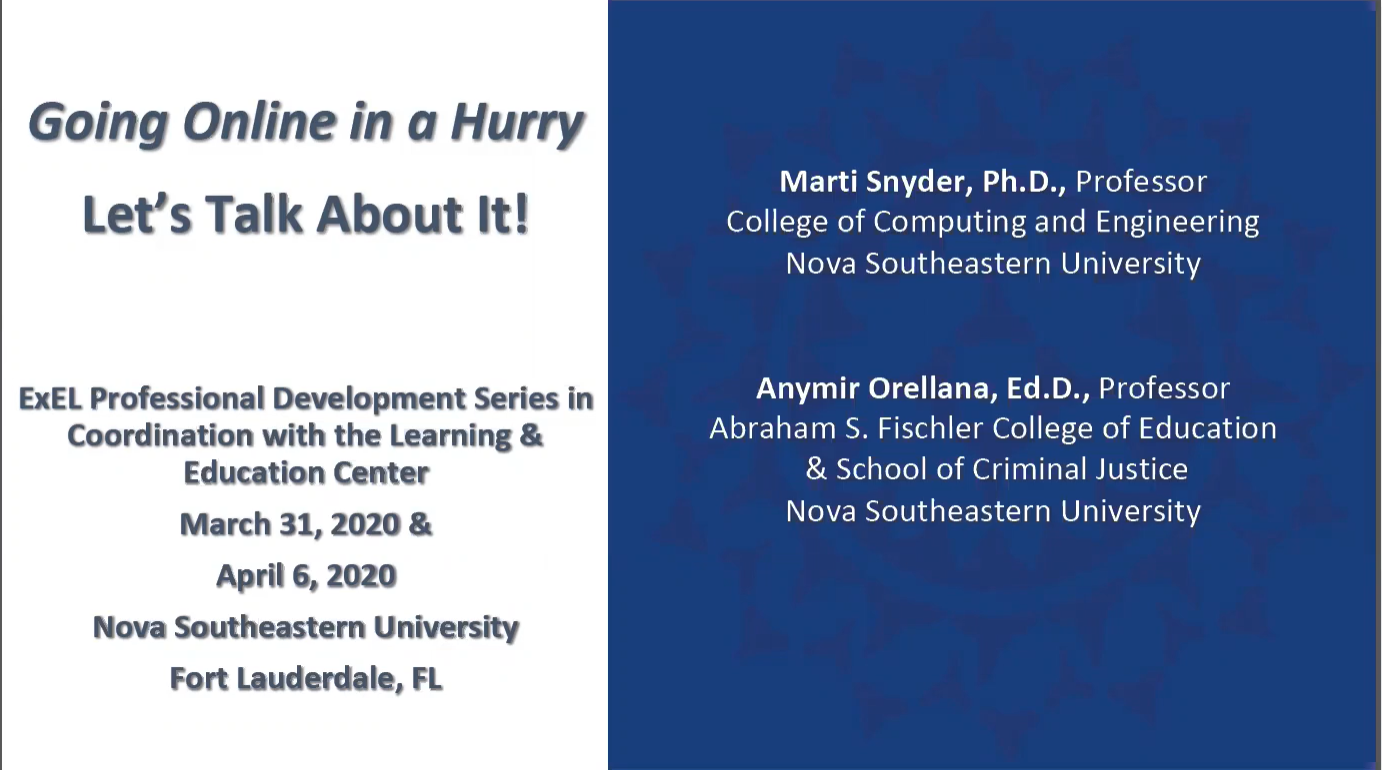This Week In The LEC: Tips and Resources for Transforming a Traditional Lab, An Exciting New Workshop, “In a Minute” Canvas Undelete, Canvas Office Hour, Zoom Updates
Issue Date: 09-18-2020
Tips and Resources for Transforming a Traditional Lab into a Meaningful Online Lab Learning Experience
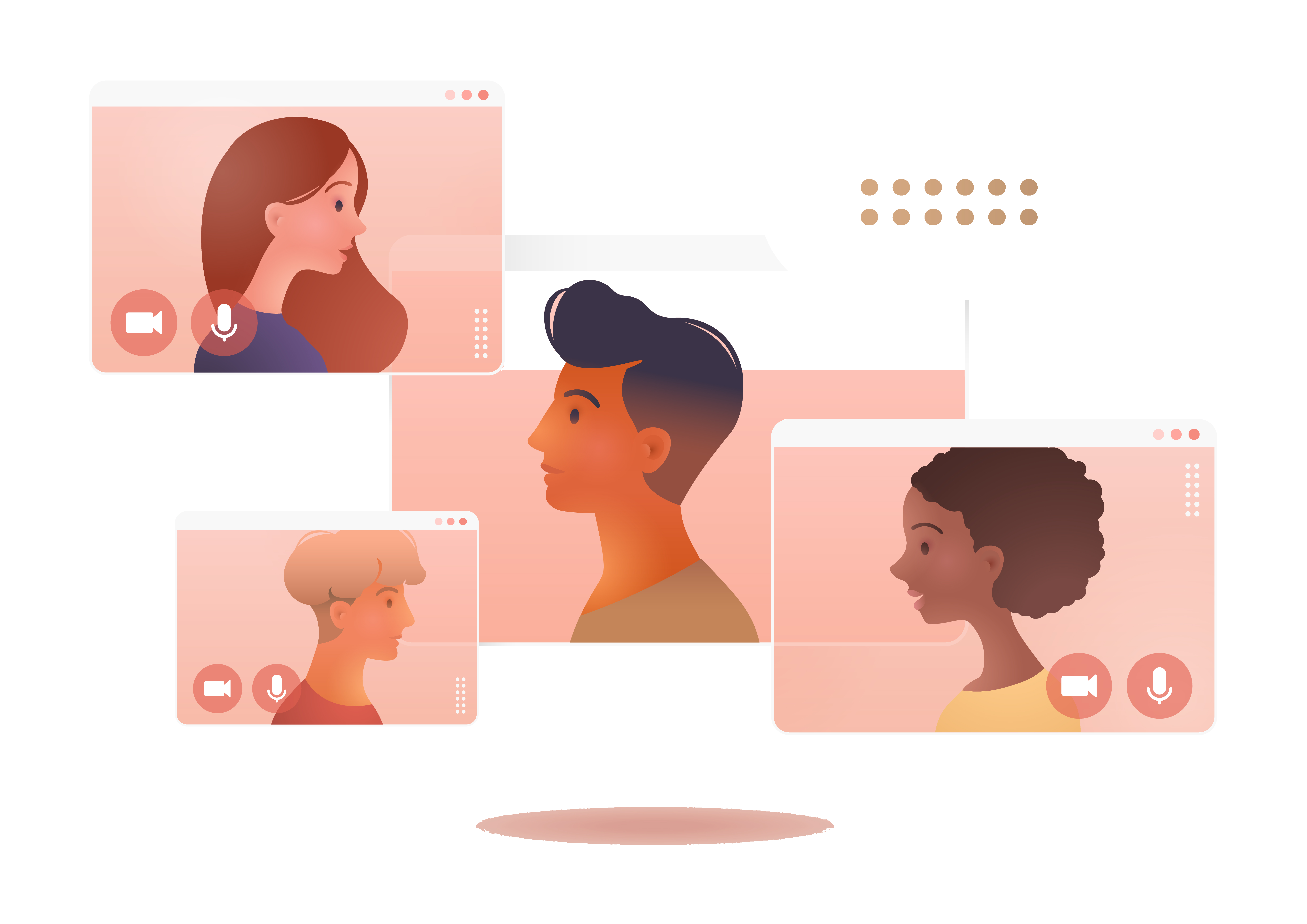
Recently during a few of our BlendFlex training sessions, faculty members raised this question: How do we teach a lab course online?
One of the biggest hurdles to teaching science labs, experiential, and performance based courses online is how to incorporate the concrete experience-lab activities. Can instructors recreate a traditional lab activity into a meaningful online lab? The answer is yes. Traditional labs can be taught online, but with some modifications and careful considerations.
Transforming How Students Think About Labs
Online science labs should still provide active learning experiences that give students frequent opportunities to ask questions, present answers, debate their peers, and address real problems. A few professors have shared their experiences from transitioning their science labs online with Inside Higher Ed and they have identified the following critical learning objectives for online scientific lab experiences that are often overlooked (Loike & Stoltz-Loike, 2020).
Objective 1: Discuss how to propose new scientific experiments.
Students in an online laboratory class can be divided into groups of two so that they can use their prior lab experience and understanding of the techniques to propose new experiments. By working in pairs, students can discuss and explore ideas.
Objective 2: Learn how to review the literature and critically read peer-reviewed journals.
Read science journals and literature regarding new discoveries in the online lab. Students could learn how to read peer-reviewed journal papers for ideas on past research regarding their proposed experiments.
Objective 3: Learn how to analyze experimental data.
Analyzing experimental data requires distinct skills that are not typically taught in a laboratory. Students can ask questions to get a better understanding on how to generate a data analysis. Students can also compare their ideas with scientists who are actually proposing experiments. This pedagogical design can stimulate creativity to help them design new experiments.
Tips for Transforming Your Lab Online
When you begin to transform your traditional lab into a meaningful online lab, please remember to focus on learning outcomes that can realistically be achieved in an online environment. Decide on a clear and fair grading policy for your online labs. Let students know up front the policy for missing a lab. Here are a few tips and lab options that can help you start developing your labs online.
- Instructor created labs - You may need to modify your in-person lab learning objectives to meet the conditions for learning in for your DIY virtual/remote lab. Try hosting live synchronous sessions in Zoom to keep yourself connected with your students as you describe or guide the process of the lab exercises. Students can get answers from you when they have questions or need help. Use polls to compare and discuss results. You can easily create your own activity guides using videos to explain safety precautions and data analysis as students begin to work on the lab assignments.
- Create online modules for your lab exercises - You can guide students through lab activities within an online course in a recommended order. However, it may be helpful to allow some degree of flexibility within the learning process of the module. As students’ progress within the module, poll them on the choices, predictions, or observations that they have made. Also, all assignments/activities within the module could be completed by the end of a unit, module, or semester.
- Lab Kits - You can order lab kits from companies, such as Hands-On Labs, eScience Labs,and Carolina. If a lab could be performed at home and students just need supplies, this is a great option.
- Virtual labs and simulations - These modalities also provide students with virtual experiments. Some open-access resources are available for the students who take introductory lab courses, such as PhET simulations and BioInteractive. Some companies have more detailed simulations that walk students through experiments as if they were in a laboratory or doing field work, such as Labster, McGraw Hill Connect Virtual Labs,and Beyond Labz.
Students benefit from clear and simple lab instructions in online labs. Try to steer away from using several different platforms to create your online laboratory. Let students know what they will be doing and what they need to pay special attention to throughout the lab. Providing short pre-lab videos, procedural videos for activities, and multiple visuals throughout the course and labs is extremely helpful and encourages students to stay engaged.
A few online lab resources are listed below. If you have resource that you found to work well in your lab class, please share it and we will include it on the website where this article is found. Send your name along with the Web Resource to jt245@nova.edu.
Additional Resources for Online Labs
Online Resources for Science Laboratories (POD) – Remote Teaching: All Resources
Open Educational Resources: Simulations And Virtual Labs
Lab Options For Distance Delivery
References:
Heather R. Taft. (March 17, 2020). “How to Quickly (and Safely) Move a Lab Course Online”. The Chronicle of Higher Education. Retrieved from https://www.chronicle.com/article/how-to-quickly-and-safely-move-a-lab-course-online/
Loike, J., & Stoltz-Loike, M. (April 8, 2020).”How to Rethink Science Lab Classes” Inside Higher Ed. https://www.insidehighered.com/advice/2020/04/08/five-objectives-online-science-labs-lend-themselves-virtual-teaching-opinion
"In a Minute" Video Series - Canvas - Undelete
We are pleased to present the first video in our new "In a Minute" series. In the series we will share tips on topics ranging from Canvas to Zoom, ways to enhance your courses, pedagogical practices and resources. These one-minute videos are intended to be simple suggestions that are easy to implement. If you have a tip to share, we would love to feature your video in an upcoming newsletter. Email us at LEC@nova.edu
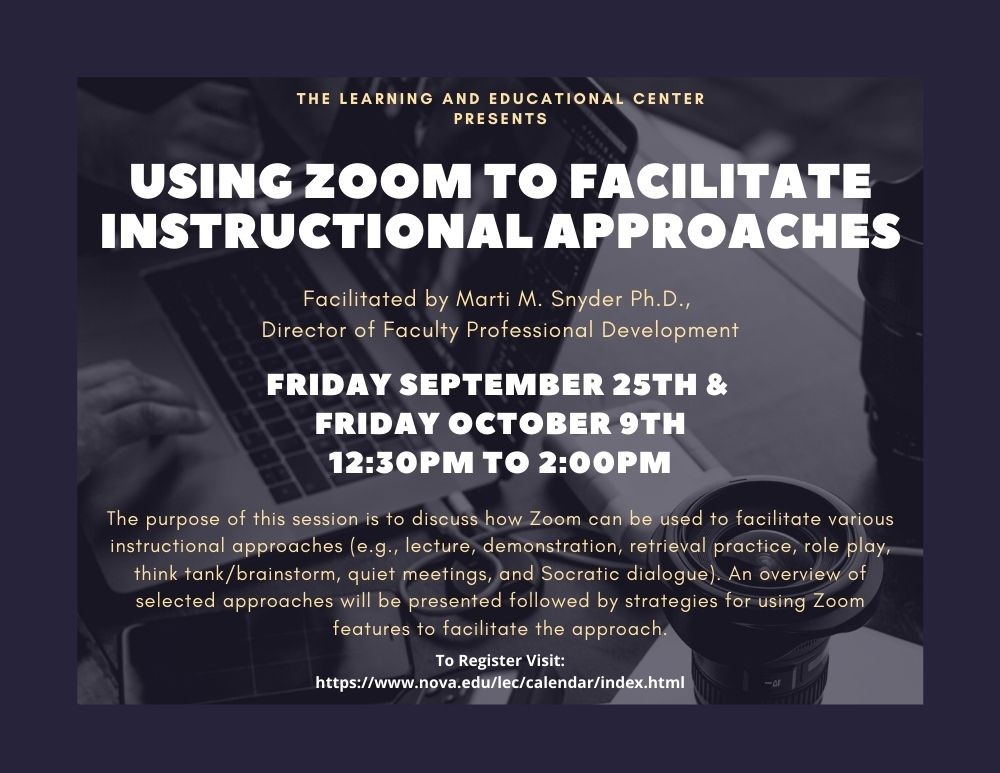
Using Zoom to Facilitate Instructional Approaches
Facilitator: Marti M. Snyder, Ph.D., Director of Faculty Professional Development, NSU Learning and Educational Center | Office of Academic Affairs
Description:
The purpose of this session is to discuss how Zoom can be used to facilitate various instructional approaches (e.g., lecture, demonstration, retrieval practice, role play, think tank/brainstorm, quiet meetings, and Socratic dialogue). An overview of selected approaches will be presented followed by strategies for using Zoom features to facilitate the approach.
Pre-registration is required. There is a 30-participant limit for each day. After registering, you will receive a confirmation email containing information about joining the meeting.
Learning Objectives:
Participants will:
- Identify and describe various types of instructional approaches that they can use in their teaching
- Apply Zoom tools and techniques to facilitate these instructional methods
Sep 25, 2020 12:30 PM - 2:00 PM Eastern Time
This session is full. Please register for the October 9th Session. Only 3 seats remain available for October 9th.
Oct 9, 2020 12:30 PM - 2:00 PM Eastern Time - Only 3 Seats remain available
To Register for this course visit - https://nova.traincaster.com/app/Login.pm?course_code=instappoct9 select Traincaster, log in, and then click on Classroom Schedule.
To browse other course offerings visit https://nova.traincaster.com
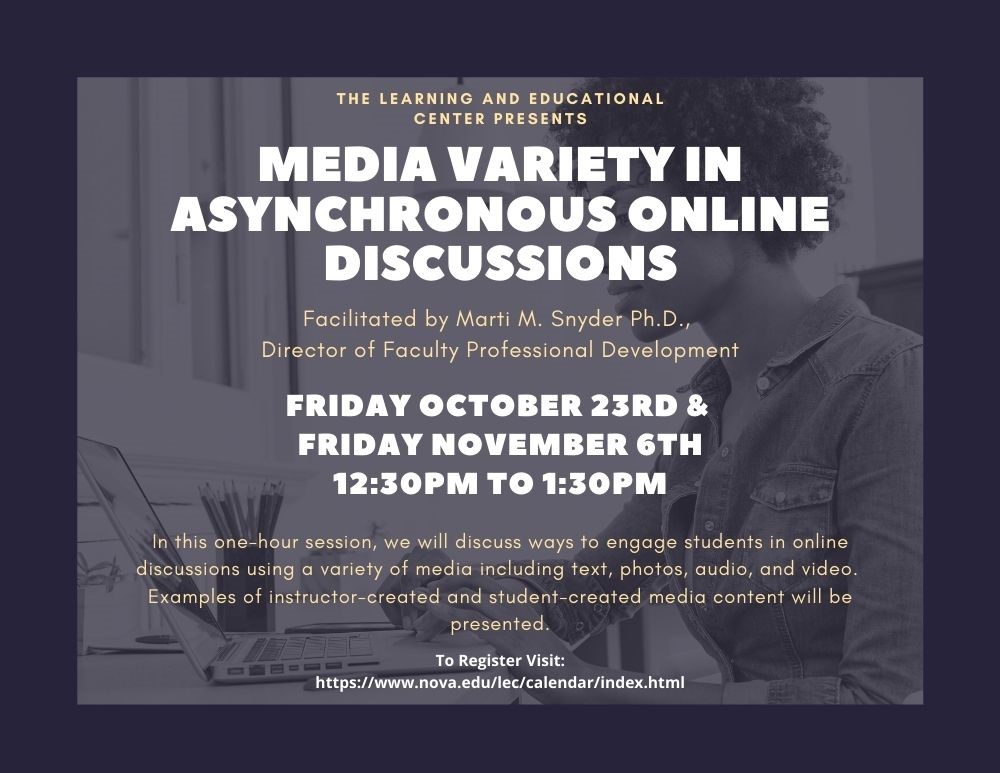
Media Variety in Asynchronous Online Discussions
Facilitator: Marti M. Snyder, Ph.D., Director of Faculty Professional Development, NSU Learning and Educational Center | Office of Academic Affairs
Description:
In this one-hour session, we will discuss ways to engage students in online discussions using a variety of media including text, photos, audio, and video. Examples of instructor-created and student-created media content will be presented.
Learning Objectives:
Participants will:
- Describe the purpose and uses for asynchronous online discussions.
- Discuss why media variety is important in engaging online learners.
- Identify examples of how various media (e.g., text, photos/graphics, audio, video) can be used by instructors and students to create an engaging online discussion.
Pre-registration is required. There is a 30-participant limit for each day. After registering, you will receive a confirmation email containing information about joining the meeting.
October 23, 2020 12:30 PM – 1:30 PM Eastern Time
To Register for this course visit - https://nova.traincaster.com/app/Login.pm?course_code=instappoct23 select Traincaster, log in, and then click on Classroom Schedule.
To browse other course offerings visit https://nova.traincaster.com
November 6, 2020 12:30 PM – 1:30 PM Eastern Time
To Register for this course visit - https://nova.traincaster.com/app/Login.pm?course_code=instappnov6 select Traincaster, log in, and then click on Classroom Schedule.
To browse other course offerings visit https://nova.traincaster.com
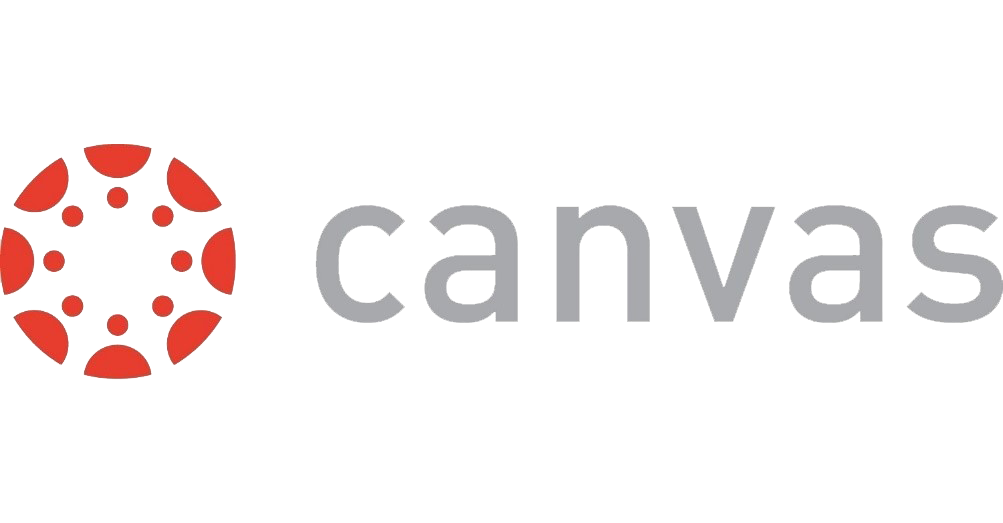
Canvas Office Hour with Canvas CSM
Come join our Canvas Customer Success Manager (CSM) Jonathan Burnos during a Zoom session where he will review:
- An introduction to Canvas Community
- Canvas Resources and Guides
- Information to include with a Case to Support
Friday, September 25th, 2020
3:00 pm to 4:00 pm EST
https://instructure.zoom.us/j/99804331097
For questions about the session, contact jonathan.burnos@instructure.com
Register for the New BlendFlex Training Self-Paced Course

The Learning and Educational Center (LEC) is pleased to announce the release of the new Self-Paced “Teaching in the BlendFlex Model” online training. The asynchronous course consists of four modules and should take approximately 90 minutes to complete.
Each module includes previously recorded sections of the live training as well as interactives. Of particular note is the Module 2 simulation. The interactive representation of the Zoom dashboard includes a hands-on walkthrough of how to use the cameras as well as 4 suggested tools that can be used for student engagement.
After successfully completing all four modules and a final quiz, the instructor will be awarded a certificate of completion.
The course is now available and directions on how to self-register can be found here. Below is a link to a video walkthrough to help guide you register for the new Self-Paced BlendFlex Training.
We are continuing our Zoom based live training of Teaching in the BlendFlex Model and there are 5 more opportunities to join our sessions. Either the Zoom based live training, or the Self-Paced course meets the requirements.
Tips from OIIT on BlendFlex Classroom Technology
In support of the BlendFlex Model and the Return of the Sharks in our new "normal", classrooms have been enhanced with additional video technology capabilities. The podium computers have cameras connected to facilitate video conferencing and Zoom related activities. Please avoid improper handling of the equipment as much as possible. Below are some tips to follow for the new podium equipment to prevent improper handling of the equipment:
Podium Computer Tips
- Do not re-locate the cameras on the podium. They have been set for maximum coverage of the instructor and the classroom.
- Do not disconnect any of the camera equipment located at the podium.
- Do not move the podium
- Do not wipe the touch screens or touch panels with any type of Clorox, alcohol, or moist cloth (this will ruin the display). OIIT and facilities will clean the equipment.
- Leave all materials, instructions, and remote controls at the podium when your class is over.

On each podium you will notice an icon titled "Live Tech Chat" (pictured above). This icon can be used to quickly get assistance with in-classroom technology. Alternatively, you can contact Desktop Support at 954-262-0070.
BlendFlex Model
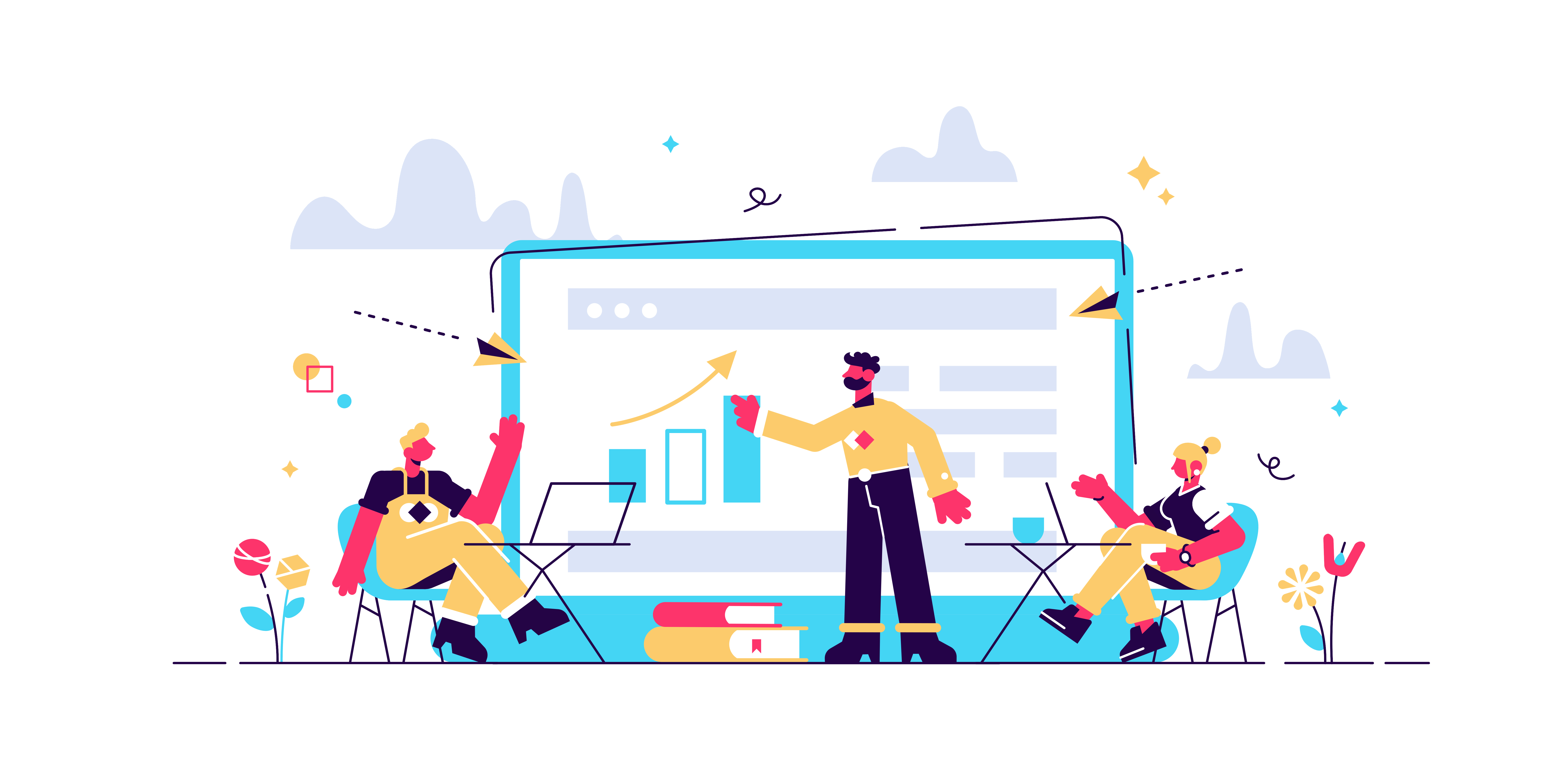
The BlendFlex model is an innovative course delivery method that offers Face-to-Face, Online, and Hybrid student experiences running simultaneously. NSU BlendFlex attendance options include attending: on campus in a traditional classroom setting, from a remote location (regional center, home, work) using videoconferencing type technologies including Zoom as well as the LMS Canvas.
For a list of courses, resources, and technical support, visit https://www.nova.edu/lec/blendflex.html.
BlendFlex Model Frequently Asked Questions
Get answers to your most frequently asked questions. If you have a question that has not been addressed, please submit your question to the Learning and Educational Center at lec@nova.edu.
Visit https://www.nova.edu/lec/blendflexfaq.html to get answers to your frequently asked questions.
Updates to Respondus Lockdown Browser

We wanted to make you aware that the Office of Innovation and Information Technology (OIIT) became aware of a bug that allowed Lockdown browser users to circumvent the lockdown browser controls and access the web during a test. After working extensively with the vendor, OIIT is glad to announce that there is an automatic update available that has resolved the issue. The next time a student uses the software they will be prompted to complete the update in order to use the software.
If you are a new Respondus Lockdown Browser user, they have Webinars available for you to learn more about how to use the tool. For Faculty questions or assistance please contact Remotehelp@nova.edu or call 954-262-0070. If your students need assistance with Lockdown Browser they can get the software and get help through the student help desk and ask questions at help@nova.edu.
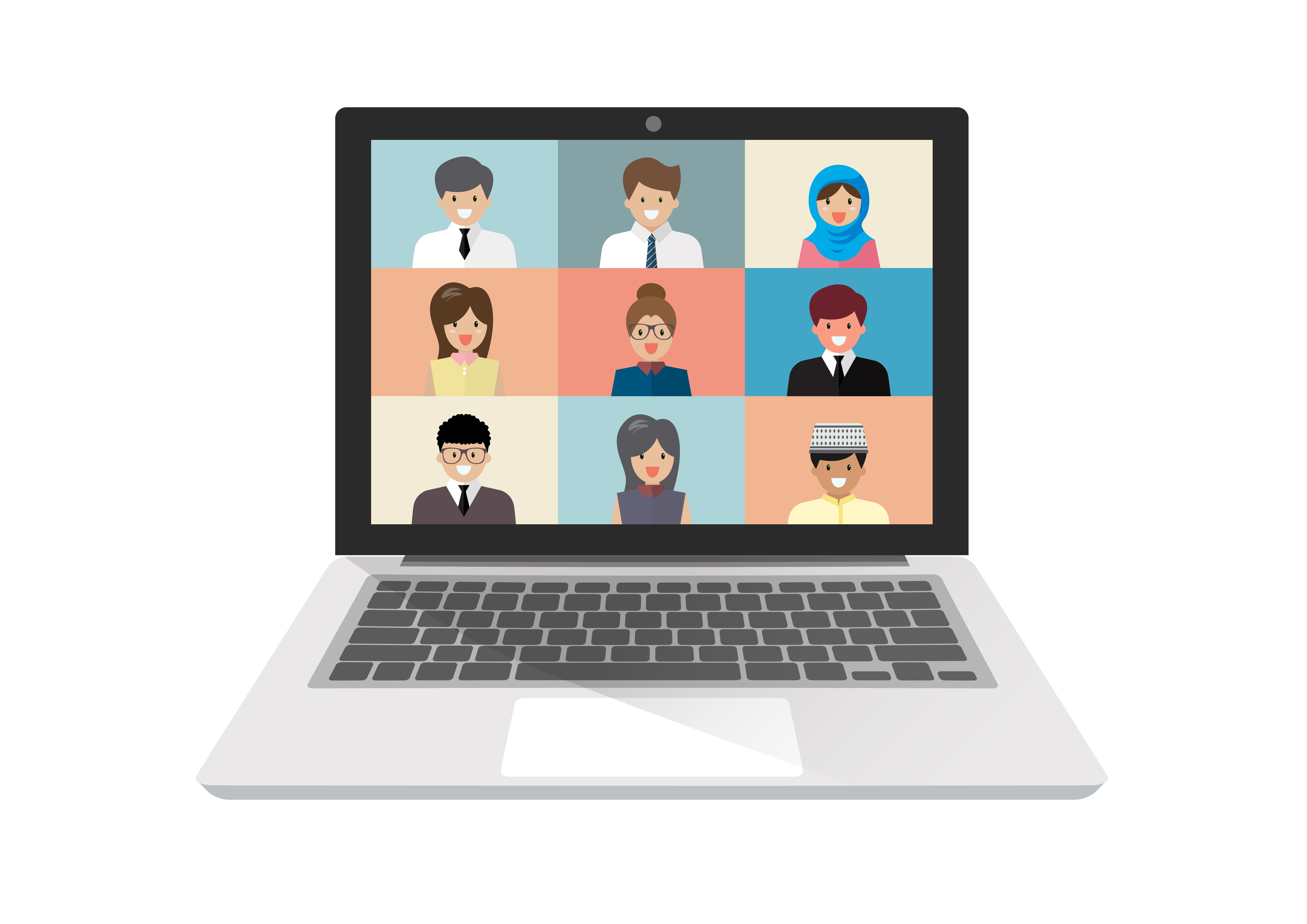
Zoom News
In Zoom News, recent updates have brought along a host of new features such as high fidelity audio mode, custom gallery view organization, multi-pin and multi-spotlight and coming next week, Self-Select for Breakout Rooms. Custom Gallery View provides instructors the ability to customize the view that is being shared with students, which is helpful in situations where the instructor wants to have specific students share during a class and can now place those designated students in a particular order on screen that is also then shared with the rest of the class.
In the next update which is scheduled for Monday 9/21, Self-select Breakout Rooms will be available and allow students to move between groups. This could be very useful in a class where you may be having groups work together but send over a representative to another group to present an idea or gather information. Another feature that is important to the BlendFlex classroom is the ability to share multiple programs at once. This allows the instructor to share multiple items without having to stop and restart sharing when switching items to share.
Meeting features
- High Fidelity Audio mode
This option in Advanced Audio enhances “Original Audio” mode, allowing for disabling echo cancellation & post-processing, while raising audio codec quality to 48Khz, 96Kbps mono/192kbps stereo for professional audio transmission in music education and performance applications. Professional audio interface, microphone, and headphones required.
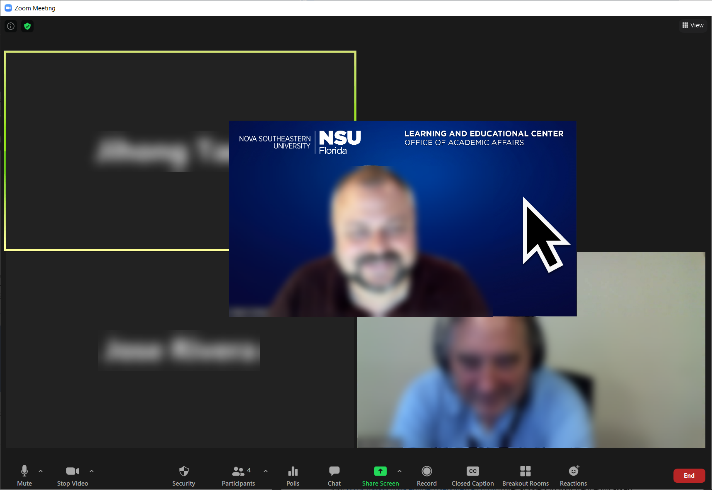
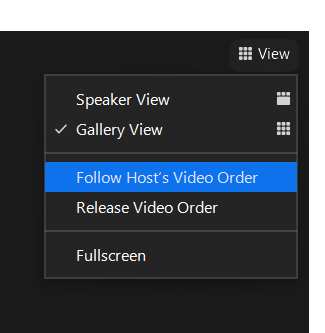
- Custom gallery view organization
Host and co-host can now re-order the gallery view to suit their needs, and choose whether to deploy this view to participants, or allow participants to create their own custom views. Simply click and drag videos to the position you want them in gallery view, and this layout will remain in place until released. - Multi-pin and multi-spotlight
With host permission, users will now be able to pin up to 9 participants on their end. The host can also spotlight up to 9 participants for everyone in the meeting.
Meeting features (Coming September 21st)
- Self-select Breakout Room
The host can now create breakout rooms with the option for participants to self-select which breakout room they would like to join. If enabled, participants can move freely between breakout rooms, without needing the host’s help. - Share multiple programs at once
Users can now select multiple programs to share, allowing them to switch between those during a presentation without interrupting the share or showing their entire desktop view.
The full details of all updates are available on the Zoom Website. As always, be sure to keep your Zoom software up to date.
To update your Zoom Application, check out these directions- https://support.zoom.us/hc/en-us/articles/201362233-Where-Do-I-Download-The-Latest-Version

Register for a Zoom Meeting for Education Webinar
These webinars are provided by Zoom.
Duration: 45 minutes
Prerequisites: An understanding of e-mail and video conferencing principles is helpful.
In this session you will learn:
1) How to download the Zoom applications and join a Zoom meeting;
2) How to schedule a meeting and send out invitations;
3) In-meeting controls and differentiation tools (including the waiting room, share screen, breakout rooms).
Time will be allocated at the end of the session for live Q&A.
Note: We will be delivering training using Zoom's Webinar platform. This will ensure your privacy during this webinar.
To Register for a webinar, click here.
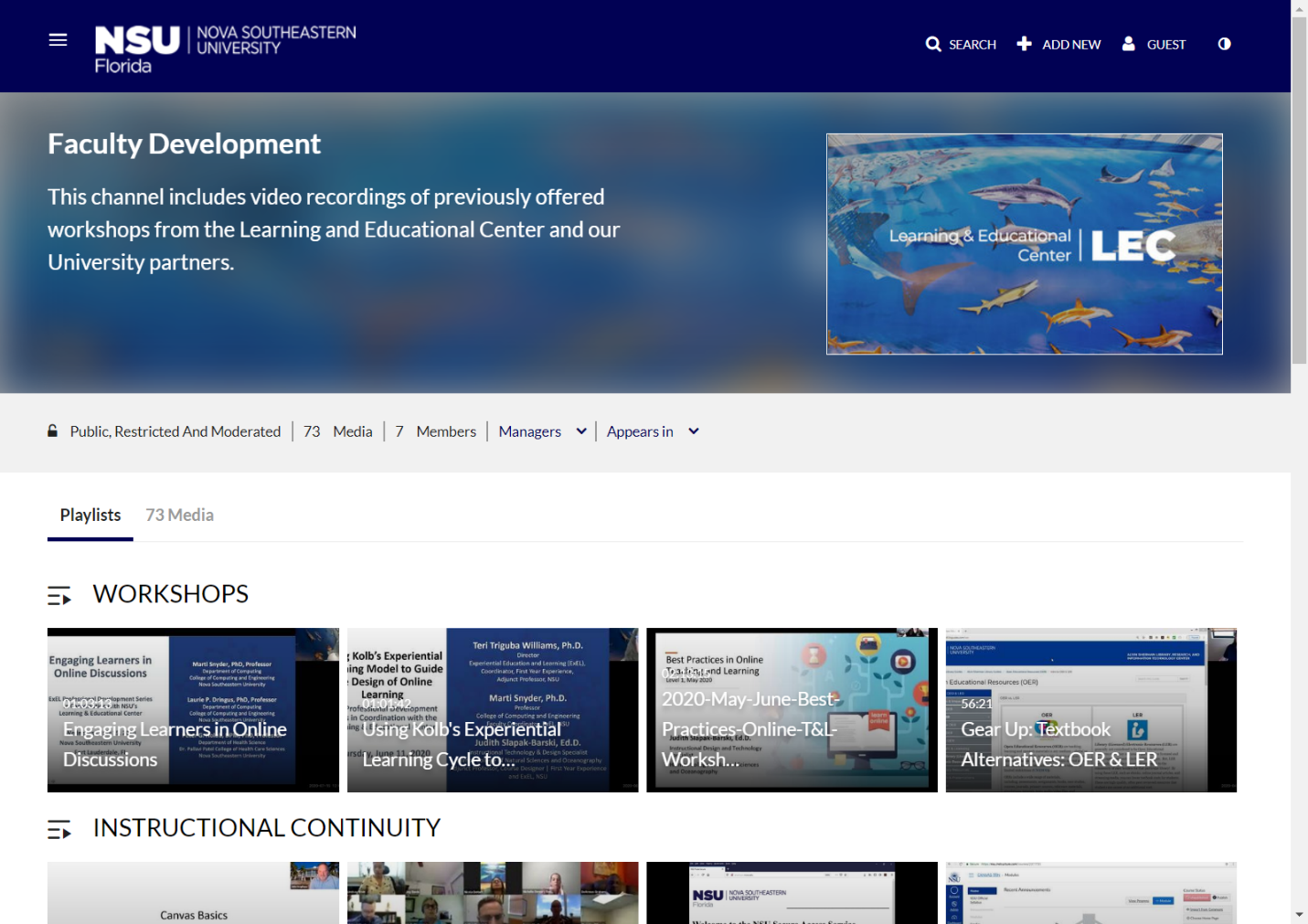
Faculty Development Channel on Sharkmedia
Through our partnerships with various colleges and departments, there have been several valuable workshops that were held which you may not have been able to attend. Check out our SharkMedia Channel to see recordings of past workshops such as:
ExEL Professional Development Series: Experiential Education 101- WHAT, WHY, and HOW
ExEL Professional Development Series: Going Online in a Hurry- Let's Talk About It!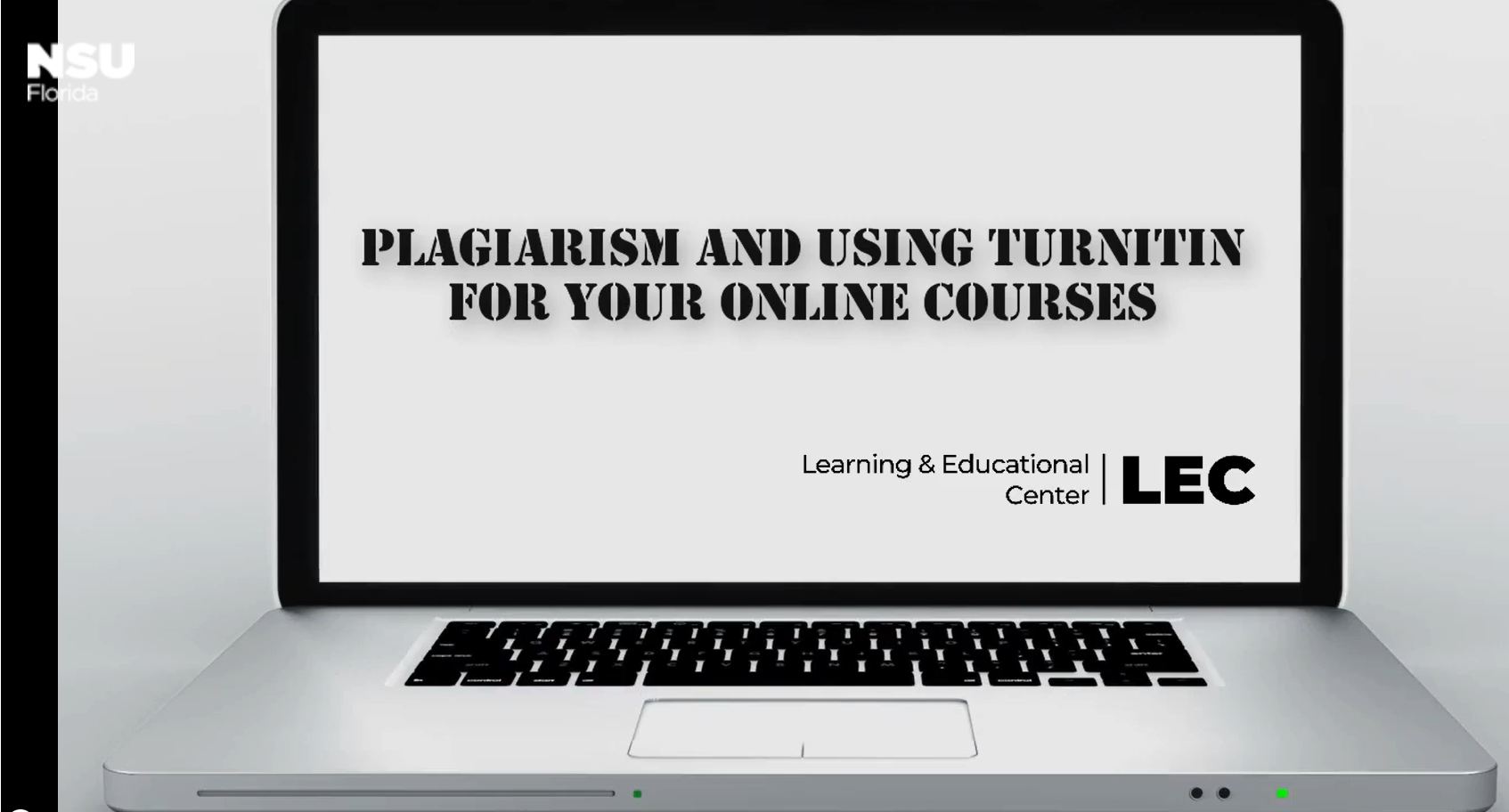
Plagiarism and Using TurnItIn for Your Online Courses
These workshops and additional video assets are all available in the LEC Faculty Development Channel.
Remote Technical Help
Faculty and Staff who need assistance, please feel free to contact NSU Support:
Email to remotehelp@nova.edu.
Faculty & Staff Support Hotline at 954-262-0070
Submit a ticket for technical assistance through ServiceNow.Tags: Training, LEC, Canvas, Workshop
